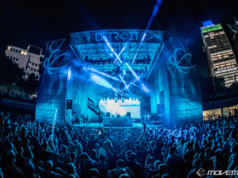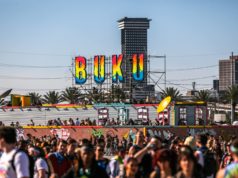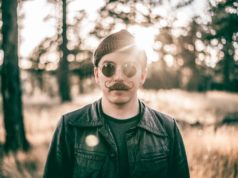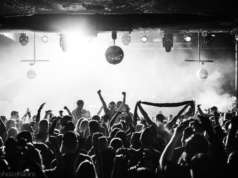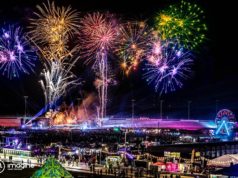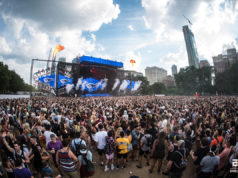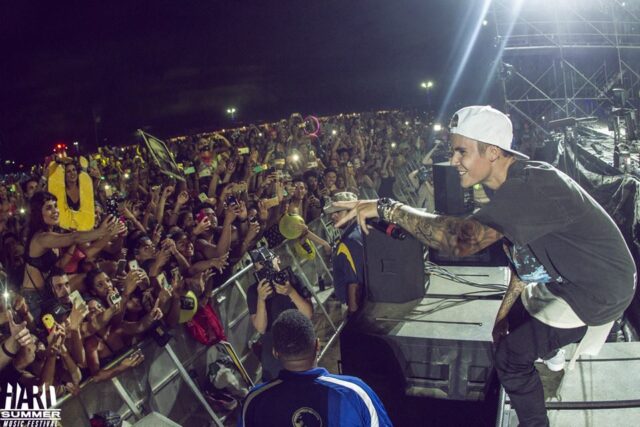
Last weekend, the 2015 installment of HARD Summer came to a close. Hailed as \”the biggest HARD ever\” the lineup boasted such giants as Jack U, Zeds Dead, RL Grime, and The Chemical Brothers, but does bigger always mean better when it comes to festivals? From the eyes of someone who has been regularly attending HARD events for the past few years (my eyes) the answer is obvious: no. What started out as an awesome LA-born festival that really was all about showcasing serious talent, has turned into just another event to help fill Live Nation\’s pockets. The biggest HARD ever? Try the worst HARD ever.
Five years ago, the hearts of thousands of LA ravers sank after the death of a fifteen year old girl at Insomniac\’s flagship festival, Electric Daisy Carnival. This tragedy prompted a nation wide conversation concerning the safety of these events leaving the future of LA born dance music fans in a bleak place. An underage girl was dead because of illegal substances that are already paired with these types of events, and even though this particular rave had been taking place in LA for fourteen years prior, the number of arrests and hospitalizations continued to sky rocket. With these facts in mind the decision whether to allow these events to be held in Los Angeles was an easy one. As such, EDC will never be seen in LA again.
For some this was the worst thing that could\’ve happened. Even though these people were mostly disappointed ravers who were upset despite EDC quickly finding a new home (and mountains of success) in Las Vegas, those most devastated by the axing of EDM events in LA were the promoters.
EDC 2010 was the last to take place in LA, and EDM exploded after Avicii released \”Levels\” in 2011. Suddenly all the people who thought house music was repetitive garbage were blasting the vocals of Etta James through their speakers, and subsequently, buying tickets to the next local rave. How was LA, the music hub of the United States, going to miss out on one of largest cultural movements in decades?
That\’s where Gary Richards, aka Destructo and the leader of HARD, comes in.
HARD Events had been taking place in LA since 2007 and in 2010, HARD Summer was scheduled to occur in LA Historic Park for the first time. Going from warehouse parties to massive festivals in just three years is quite impressive, but in wake of a tragedy taking place at a similar event, Hard Summer 2010 was cancelled. Richards refused to cite one specific reason for canceling the event, but it was definitely due in part to poor ticket sales (likely an offshoot of the EDC tragedy) and the negative stigma surrounding electronic music events. However in spite of all this Richards was able to pull together a few of the artists from the original HARD Summer 2010, and put on a smaller version of the event a few weeks later. The more intimate version of the festival was an overall success so when the summer of 2011 rolled around and everyone who listened to radio was into EDM, the last and best choice for promoters and fans alike was HARD.
EDC wasn\’t coming back to LA. That was guaranteed, but the festival market was growing too fast for promoters and the city of Los Angeles to ignore. Those overseeing such public events wanted to curate a festival in the city that wasn\’t the logistical nightmare of EDC 2010, and also rejected the rave aesthetic that contributed to the death of an underage girl. Not to say HARD events hadn\’t had their own logistical issues. HARD Summer 2009 at the Forum was forcibly shut down by the police, but with Insomniac out, HARD was the only company with similar resources at its disposal. As such, HARD Summer was given the go ahead for 2011 under a new set of circumstances, and the event that resulted lead to a series of others that catered to all manner of electronic music fans, yet still managed to be separate from the mainstream rave scene.
If you were to visit EDC\’s website, the first word you would see is \”experience.\” Even though Insomniac was still booking huge names like Skrillex and Afrojack in 2011, the music was not the primary focus of their revamped mega fest. All over the site you could read about the brand new venue (The Las Vegas Motor Speedway) and how they were going to deck it out rave style with lights, performers, carnival rides, and much more.
In contrast, a quick look at the HARD Summer site would communicate the opposite. Like many festivals, the most important thing to see on the website for any HARD event from then until now was the lineup, which in 2011 included Skrillex, Odd Future, Ratatat, and more. The first thing to notice about that lineup is that even though it was mostly DJs, it was not entirely EDM centric. The inclusion of several rappers and alt. rock groups was an important step for the city of Los Angeles to allow such an event to occur in the middle of downtown. (\”It\’s not a rave it\’s a music festival.\”)
Another important step was attire. HARD Summer 2011 banned all LED toys, kandi bracelets, and other such garments that immediately scream the word \”rave\” when you see someone wearing them. To a person who attends festivals for music primarily, this would not be a big deal at all, but as EDC\’s website goes to show, giant raves like that are not just about the music. When Diplo banned kandi from his Mad Decent Block Parties last summer, the amount of internet outrage was substantial. So substantial to the point that many people decided not to attend solely based on the decision to ban kandi. The Mad Decent Block Parties were already much smaller than HARD Summer and if so many people were deterred from attending based on the inability to wear beaded bracelets, then its very likely HARD had the same result. Those who consider themselves \”real ravers\” need the kandi and the light gloves as it is a significant part of the culture. The culture of HARD was great music.
HARD Summer 2011 was a huge success for the music fans of LA. Los Angeles State Historic Park was a wide open venue, right smack dab in the middle of the city, where attendees didn\’t have to wait in line to enter one of the stages like at the coliseum. The purchase of a HARD Summer ticket also gave attendees free access to the subway for that day, so nobody had to pay for parking or worry about driving if they were not physically able, and most importantly, the music was stellar. LA natives like Skrillex and Odd Future were more than excited to be performing on a huge stage in their hometown, and it was a stepping stone for newer acts like Dillon Francis and Jack Beats. HARD Summer was now a festival the people of Los Angeles could call their own.
HARD events were on the rise at that point. HARD Summer 2012 was expanded to a two day event, and HARD\’s Halloween fest, \’HARD Haunted Mansion\’, was rebranded as \’Day of the Dead\’ and moved from the Shrine to LA Historic park for 2012 as well. HARD Summers lineup in 2012 was also the most diverse and exciting in the company\’s history. That weekend was filled with live bands like Bootsy Collins and Bloc Party, EDM all stars like Nero and Skrillex, and even a few unexpected treats like Squarepusher and Magnetic Man. However, HARD was acquired by Live Nation in 2012, and all the things that made it LA\’s home festival slowly started to fade.
By 2013 the number of those in attendance per day more than tripled from 10,000 in 2011, to almost 35,000 in 2013 (70,000 total over two days). In 2011, LA Historic Park was a local neighborhood park that had some top notch musicians, in 2013 it was just another overpacked concert venue for which kandi-clad attendees had a long list of complaints. A few common ones were \”too dusty,\” and \”not laid out well,\” even though in the past years when less people attended the event, only the devil\’s advocates had anything negative to say. Also, starting in 2013, the event ended at 12am instead of 2am and HARD stopped including metro fares with your ticket. Granted at the time a day pass for the metro was only five dollars, but it was still very convenient to remove transportation to and from the event from your thought process as it was already taken care of for you. Plus the number of live acts began to pale in comparison to the number of DJ\’s, most of which had been at HARD Summer or Day of the Dead the year before. Azalea Banks, one of the four non electronic acts at HARD Summer 2013, didn\’t even show up.
2014 was the biggest step away as LA Historic Park had to undergo (insert suspenseful horror movie sample) renovations. Suddenly HARD Summer didn\’t look the same at all, except for the increasingly static and EDM heavy lineups. In 2014, the event was moved to Whittier Narrows Recreation Area in South El Monte, CA. Even though in 2013, many logistical changes made HARD Summer a very different event, it maintained its integrity as LA\’s festival simply because it was in the middle of LA. If you turned around during HARD Summer before 2014, you\’d see the LA skyline clearly behind you. South El Monte is fourteen miles away from the center of LA, and while that may not be so far, the fact that you had pay 20 dollars each day to park and there was no clear route for public transportation, it might as well have been 50 miles away. As LA Historic Park was being renovated, there was obviously no way the event could be held there, and Richards\’ desire to keep the event within LA County is admirable, but Whittier Narrows had all the issues of LA Historic Park combined with all the issues of a first time event.
Being a community park every other day of the year, there was very little upkeep of the grass, and so after a two day festival, it might as well haven been a giant patch of dirt. The clouds of dust were so thick you could see the beams of light shining through them, and as far as the layout goes, it was a giant rectangle with the stages along the perimeter. The smaller stages were so close you could almost always hear more than one unless you were deep in the crowd, and getting from one side of the event to the other was like traveling through a storm that was half dust and half clueless ravers. If you were at the green tent and you wanted to watch someone at main stage, you had to take into account the 10-15 minutes it would take to get there. Plus if you needed water towards the end of the night, you had to buy it as the free water stations were either empty or flooded.
Whittier Narrows was such a misguided choice for a venue that just 3 months later when it was time for Day of the Dead 2014, the venue had once again changed to the Pomona Fairplex, which is even farther from LA than Whittier Narrows. Being the home of the LA County fair, the Fairplex was a much more tested venue than Whittier Narrows, but overall was still a very poor choice for a festival. The entirety of the area is concrete and asphalt, raising the temperature outside by a good 10-20 degrees under the LA summer sun. Plus giant bleachers once again made the journey from anywhere to main stage take at least 10 minutes, with the awkwardly shaped venue now holding 40,000 people per day. Another thing those who set up the fair don\’t have to worry about is sound. While the stages were all visually separate at the fairplex, there was not a moment when all three outdoor stages were at a good volume simultaneously. Perhaps this was for fear of soundbleed, perhaps it was to \”save the volume\” for the headliners, but either way after experiencing HARD Day of the Dead 2014 at the Fairplex, I was more than ready for the renovations at LA Historic to be complete.
Unfortunately as Spring 2015 rolled around and the HARD Summer lineup was days away from being released, there were two pieces of information that were disconcerting: 1. That HARD Summer would once again return to the Fairplex, and 2. it would be \”the biggest HARD ever.\” The Fairplex was already way overpacked last time, and now they were planning on putting more people in there. There ended up being over 60,000 people per day, and this lead to utterly humid tents, speakers that were overshadowed by rambling crowds of people, long lines at the food stands, and an overall claustrophobic vibe that was very detrimental to the festival experience as a whole. Plus every stage other than the HARDer stage (where the live acts played) was so effin quiet. The tents only got louder at around 630 PM (the event ended at 11 on Saturday and 10 on Sunday) and main stage was quiet all weekend. Did I also mention it took some people over two hours just to get out of the parking lot as there was only one exit open for thousands of cars?
One thing that distracted from the issues though was the fact that 2015 did have an absolutely amazing lineup. It was the first to depart from the predictable, EDM centric rosters of the past few years. (In 2013 and 2014 Justin Martin was at four out of four major HARD events. Zeds dead, Nero, Calvin Harris, and many others were at two of four). With a slew of live acts including a headlining set by The Weeknd, it was fair to say that HARD Summer was a music festival and not a rave, however it emphasized another problem that had been brewing with HARD events, scheduling. Other than several acts (Brodinski, Young Thug, Robin Schulz) being cancelled last minute, so many artists overlapped partially or completely. Obviously for those with a wide variety of taste, the schedule will always be an issue, but to have so many of the more respected names play at the same time is just plain frustrating. From 7:30 to 8:30 on Sunday of HARD Summer 2015, RL Grime, Chromeo, Boys Noize, and MK were all playing. I\’m aware that many of the people who would want to see RL Grime at main stage wouldn\’t necessarily be interested in seeing Boys Noize at a small tent, but RL Grime, Boys Noize and Chromeo were all in headlining positions on the lineup poster, which means they are the ones who draw the crowd, and are the artists most people want to see. So the first time HARD\’s lineup was really different in almost three years, was the time it was impossible to see all those that made it different. All through out the festival I overheard people urging their friends to leave a stage because they had to catch ten minutes of someone else.
If one were to examine social media after the conclusion of HARD Summer 2015, it was clear that from HARD and Live Nations point of view, it was a success. Selling out weeks before the event, receiving massive love all over the internet (YourEDM called it \”the best festival in America\”), and hosting some admittedly legendary performances. (Jack U brought out Justin Bieber very quietly, and the Chemicals Brothers were the coolest thing I had seen at any HARD event in my five years of regular attendance.) But what is the cost, other than the ever increasing ticket prices? Every year the festival that started out as an awesome concert in LA\’s backyard is starting to look more like a sub par county fair mixed with a scaled back version of Coachella. HARD Summer is just another popular event now, which leaves LA without a true hometown festival once again.

